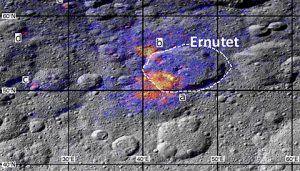The Dawn spacecraft has detected organic compounds on the dwarf planet Ceres.

NASA / JPL-Caltech / UCLA / ASI / INAF / MPS / DLR / IDA
Reporting in the February 17th Science, Maria Cristina De Sanctis (INAF Institute for Space Astrophysics and Planetology, Italy) and other members of NASA’s Dawn mission have found a big patch of organic compounds high in the northern hemisphere of the dwarf planet Ceres. Ceres is the largest member of the asteroid belt, and the Dawn spacecraft has been exploring it since 2015.
Organics are not surprising in of themselves. Scientists have found them in meteorites (many of which come from asteroids), and we’ve also seen hints of them on the main-belt asteroids 24 Themis and 65 Cybele. But the signal Dawn picked up is much clearer than the ones from those other asteroids.
The organics drape over the southwest floor and rim of the 50-km-wide crater Ernutet, with a few blobs nearby. However, the compounds don’t look to be connected to the crater itself; they're spread across about 1000 km2. Dawn also detected at least one more, much smaller deposit in Inamahari Crater, about 400 km from Ernutet.
Unfortunately, the scientists couldn’t actually tell what the stuff is, just that it looks like aliphatic organic material. Aliphatic and aromatic are two types of compounds. Aromatic organics have molecular rings of carbon atoms and are fairly “processed,” chemically speaking; aliphatic compounds instead generally have straight chains of carbon atoms and have been less affected by heat and radiation.
There are two reasons the result is interesting. One, Ceres also has tons of water ice, plus carbonates and salts. The addition of organic material makes the dwarf planet a promising environment for prebiotic chemistry.
Two, the organics don’t seem to have been delivered by impacts — no clear cause-and-effect with particular craters, plus a hit probably would have distributed the stuff in diluted form along with other debris. Not to mention there’s other, clearly native material mixed in. Instead, the organics likely come from Ceres itself. Perhaps they’ve been brought up from below by some process, although how remains an open question. Scientists also recently suggested the little world might have a history of ice volcanoes, so maybe it’s more active than we suspected.
Read more about the result in the Southwest Research Institute’s press release. You'll find an in-depth recap of Dawn's discoveries in our December 2016 issue.
Reference: M. C. De Sanctis et al. “Localized aliphatic organic material on the surface of Ceres.” Science. February 17, 2017.
 1
1









Comments
Jim-Baughman
February 20, 2017 at 1:46 pm
Grandma Grammar here.
Second paragraph: “Organics are not surprising in of themselves...” should be “Organics are not surprising in AND of themselves...”
Also—Ceres has merely “tons” of water ice (paragraph five)? That would mean Ceres is the driest object in the solar system. All the results from Dawn point to the opposite, that there is an abundance of water ice on Ceres.
The exuberant use here of “tons” as a metaphor for “a vast amount” seriously compromises this article. It is no fun being a grammar or style nanny, but in science putting things clearly and unambiguously should always trump putting them playfully or stylishly.
You must be logged in to post a comment.
You must be logged in to post a comment.